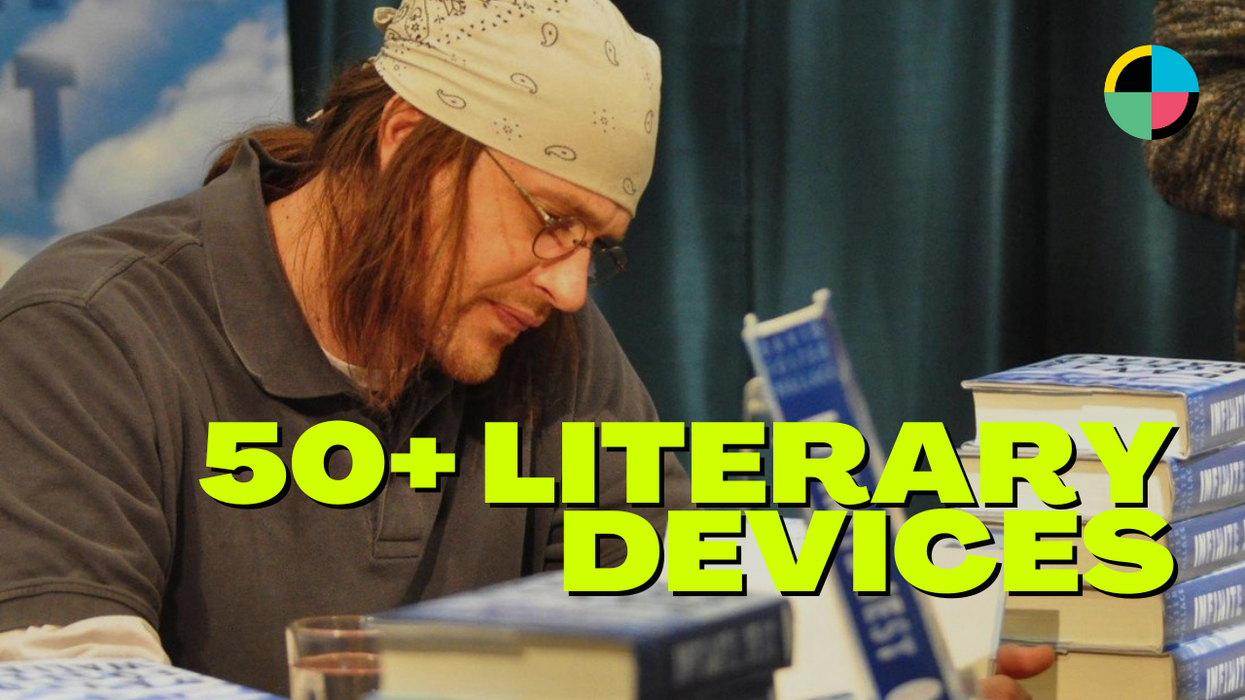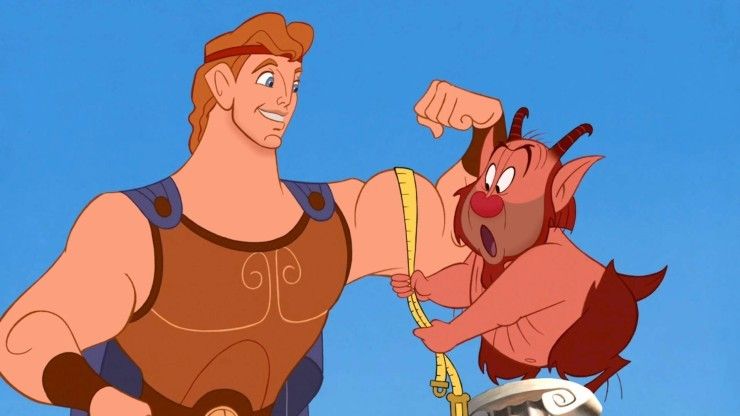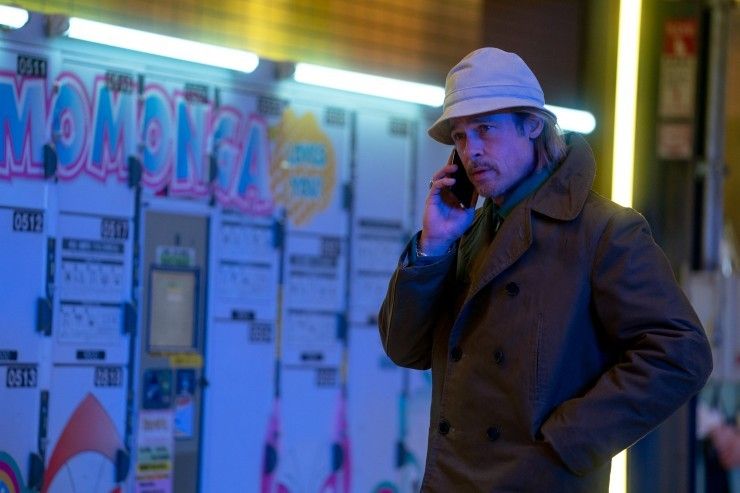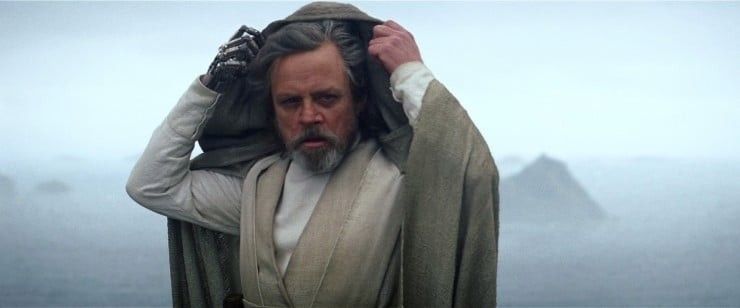50+ Literary Devices You Need to Know for Your Screenwriting
Writers of every ilk should learn these literary devices to help them in their work.

As screenwriters, we often get caught up in Googling terms and ideas that just apply to us. But one thing I've tried to do recently is open myself to all sorts of other kinds of prose and the lessons that come with it. Of course, without the foundation of fiction writing, we'd never have storytelling for the screen.
Today, I want to teach you 50+ literary devices that can open up your screenwriting and storytelling skills. They are terms you might already be using without knowing the greater theory behind them. And they can help you a lot with your mastery of the craft.
Ready? Let's dive in.
50+ Literary Devices You Need to Know for Your Screenwriting
50+ Literary Devices For Screenwriters
Allegory
An allegory is a story, movie, or TV show that can be interpreted to reveal a hidden meaning. Think about how Avatar deals with imperialistic oppression.
Alliteration
An alliteration is the succession of words that all start with the same letter. Like how in V for Vendetta, the character of V only speaks in words that begin with V.
Allusion
An allusion is a figure of speech in which something unrelated is referred to, so the audience can make the connection. When someone says, "Chocolate is my Kryptonite," they are alluding to Superman and how Kryptonite renders him weak and unable to fight back.
Anaphora
An anaphora is a figure of speech in which words are repeated at the beginning of successive phrases. Think about a movie likeFight Club, where someone says, "The first rule of Fight Club is... The second rule of Fight Club is..." and so on. That's an anaphora.
50+ Literary Devices You Need to Know for Your Screenwriting
Anastrophe
Anastrophe is a literary device in which words are put out of order. The best example of this is when Yoda in Star Wars talks in lines like, “The greatest teacher, failure is.”
Anthropomorphism
Anthropomorphism is the attribution of human characteristics to an animal or object. Think about characters like Mickey Mouse and the horses in My Little Pony, which have human traits but are animals.
Aphorism
Aphorism is a witty observation that contains an accepted truth such as, "A bad penny always turns up."
Archetype
An archetype is a pattern that defines the characteristics of a person in your story. There are many different types of character archetypes that can be applied and tweaked for any of your screenplays.

Chiasmus
Chiasmus is a figure of speech in which a phrase is inverted so that two key concepts from the original phrase reappear in the phrase after, in inverted order.
A famous instance of this comes from John F. Kennedy when he said, “Let us never negotiate out of fear, but let us never fear to negotiate.”
Climax
The climax is a part of the narrative in which we see the highest point of tension and drama. It typically occurs at the end of the story and is a precursor to wrapping everything up.
Colloquialism
A colloquialism is a word or phrase that is not formal or literary. It is a more basic or local part of the conversation. Like saying "y'all" or, "He's as old as the hills."
Cumulative sentence
In grammar, a cumulative sentence is an independent clause that is followed by subordinate phrases or clauses, which gather details about a noun or an idea. It can also be called a loose sentence.
For example, Joan Didion uses one in her essay "Some Dreamers of the Golden Dream" where she writes:
“The San Bernardino Valley lies only an hour east of Los Angeles by the San Bernardino Freeway but is in certain ways an alien place: not the coastal California of the subtropical twilights and the soft westerlies off the Pacific but a harsher California, haunted by the Mojave just beyond the mountains, devastated by the hot dry Santa Ana wind that comes down through the passes at 100 miles an hour and whines through the eucalyptus windbreaks and works on the nerves.”
Dramatic irony
Dramatic irony takes a set of events or a scene and juxtaposes it against what's occurring on the screen (or page). The most simple example is from Romeo and Juliet when Romeo decides to kill himself, thinking Juliet is dead when we all know she's just in a deep sleep.
I like to think of it as those times in the movie theater where you're yelling at the screen.
Euphemism
A euphemism is a soft word or expression used instead of a harsher one when referring to something unpleasant. For example, when you say you were "let go" instead of saying "fired." George Carlin has a famous rant about euphemisms I'll put below:
50+ Literary Devices You Need to Know for Your Screenwriting
Exposition
Exposition, or narrative exposition, is the insertion of information within a screenplay or narrative. This information can be about the setting, backstory, plot events, context in terms of history, facts, and other things the audience needs to know in order to absorb the story to its fullest potential.

Extended Metaphor
An extended metaphor is a metaphor that extends over the course of multiple lines, paragraphs, or stanzas of prose or poetry. Or over the course of a whole movie or TV show.
Like in The Great Gatsby, where F. Scott Fitzgerald writes:
"This is a valley of ashes—a fantastic farm where ashes grow like wheat into ridges and hills and grotesque gardens; where ashes take the forms of houses and chimneys and rising smoke and, finally, with a transcendent effort, of ash-grey men, who move dimly and already crumbling through the powdery air. Occasionally a line of grey cars crawls along an invisible track, gives out a ghastly creak, and comes to rest, and immediately the ash-grey men swarm up with leaden spades and stir up an impenetrable cloud, which screens their obscure operations from your sight. […] The valley of ashes is bounded on one side by a small foul river, and, when the drawbridge is up to let barges through, the passengers on waiting trains can stare at the dismal scene for as long as half an hour."
Flashback
Flashbacks are a plot device involving the breaking of a forward narrative to show something that occurred in a character's past. The best example is in a show like Lost, where we can see extensive flashbacks that tell the story of how the characters made it to the island.
Top 10 Movies Told In Flashbackyoutu.be
Foreshadowing
Foreshadowing is a warning of a future event through context clues in storytelling. In a movie like Jurassic Park, the foreshadowing is subtle. When the helicopter is landing to take them to the park, Dr. Grant (Sam Neill) only has two female connectors to his seat belt. So what does he do? Well, life finds a way and he ties them together, foreshadowing later when we find out the dinosaurs are reproducing unchecked inside the park.
Frame story
A frame story is a narrative device used to structure a film (or any form of storytelling) where an overarching story or narrative serves as the outer framework for one or more inner stories. This outer story provides context, perspective, or a point of reference for the inner stories, which are often told by characters within the outer narrative. Frame stories can be a powerful tool for filmmakers, allowing them to weave multiple narratives together, explore different perspectives, or provide context to the central plot.
Humor
Humor is the use of comedy to alleviate tension and to entertain the audience. Humor occurs mostly in the comedy genre and is a great way to keep the audience invested in a story.
Hyperbole
A hyperbole is an exaggerated claim that is not meant to be taken literally but with some inherent truth. For example, "I'm so hungry I could eat a horse," is an outrageous statement, but there is truth to the person's massive hunger.
Hypophora
Hypophora, which is also called anthypophora, is a literary device where the speaker poses a question and then answers the question themselves. For example, in Monty Python and the Holy Grail, we get this exchange: "And how'd you get that [becoming King], eh? By exploiting the workers! By hanging on to outdated imperialist dogma which perpetuates the economic and social differences in our society."

Imagery
Imagery is visually descriptive or figurative language. All screenwriters need this for their action lines.
In Medias Res
In medias res is a literary device that in Latin roughly translates to "into the middle of things." It describes a story that begins in the middle, at a crucial point in the action. For example, in Pulp Fictionwe pick up with a couple already talking about robbing a diner.
Irony
Irony is a literary technique where the full significance of a character's words or actions is clear to the audience but unknown to the character. It's basically giving the viewer all the information and making the result of that information affect the character.
Isocolon
An isocolon is a sentence or series of short sentences that have similar structure and length. The most famous isocolon is Julius Caesar's "Veni, vidi, vici," meaning, "I came, I saw, I conquered."
Juxtaposition
Juxtaposition is a literary device that compares two things to one another by placing them side by side. For example, in The Wizard of Oz, we seehow the sepia and color represent two very different worlds for Dorothy (Judy Garland).
Litotes
Litotes are words said in an irony where an affirmative is expressed by the negative. For example, when you say, “I don’t hate it,” and, "You're not wrong," you are using litotes.
Malapropism
Malapropism is the accidental use of a word after confusing it with one that sounds the same. An example would be Archie Bunker on All in the Family. He was famous for saying things like, “What do I look like, an inferior decorator?” instead of “interior decorator,” and, “In closing, I’d like to say Molotov!” instead of “Mazel tov.”
Metaphor
A metaphor is a figure of speech in which a word is attached to an object or action that is not literally true. Like saying, "His chin was granite." In movies and TV, a metaphor can be a visual representation of the theme, like in Inside Out, where we meet the characters responsible for a child's mood.
Metonymy
Metonymy is the use of a term to stand in for an object or concept. Then, you link that term to something else. As in, "The pen is mightier than the sword." In this example, you're showing that the written word can be more effective than taking up arms.
Motif
The motif refers to the recurring thematic elements in a film. These elements must be repeated in a significant way or a way that conveys a purposeful pattern. Like how the light and dark sides fight in Star Wars.

Onomatopoeia
An onomatopoeia is a word that represents a sound.
Oxymoron
An oxymoron is a figure of speech in which contradictory terms appear together. They are terms like, "jumbo shrimp" and "a silent scream."
Paradox
A Paradox is a storytelling device that contradicts itself because it contains two divergent truths. Like when you say, "One thing I know is that I know nothing." These are popular devices in science fiction, with elements like time travel and time dilations, which can seem counterintuitive but also work for the story.
Personification
Personification is the giving of human characteristics to something nonhuman. In movies and TV, think of things like The Brave Little Toaster or any of the animals in Disney animated movies.
Point of View
The point of view is the personality from which we see the story unfold. In storytelling, the point of view refers to how the filmmaker, character, or narrator tells the story the audience can see on screen. This perspective is chosen by the writer.
It can be omniscient, limited, or specialized, depending on what the writer chooses.
Polysyndeton
Polysyndeton is a stylistic device in prose writing where similar conjunctions are used in succession in order to achieve a rhythmic effect. Like, "Jason did the dishes, brushed his teeth, fluffed the pillows, fell asleep, woke up, brushed his teeth, ate off the dishes..."
Repetition
Repetition is the use of the same word or phrase multiple times to emphasize a point. Like saying, "Boys will be boys."
Satire
Satire is the use of humor, irony, and exaggeration to criticize and highlight human flaws in issues like political, racial, financial, and environmental topics. Think about movies like Don't Look Up and The Big Short.

Simile
A simile is the comparison of one thing to a different thing. This is used to make a description more tangible, as in, "Crazy like a fox," and, "Hungry as a bear."
Situational Irony
Situational irony is a storytelling device that occurs when expectations about something to happen are defined by what actually happens instead. It is the literary device equivalent to the rug being pulled out from under you.
In movies, it's like when inThe Social Network, a guy who made a friend-finding app is alone at the end of the movie.
Soliloquy
A soliloquy is the act of speaking your thoughts out loud, whether by yourself or with a crowd of people. In film and TV, it's when we share the inner thoughts of the character.
Suspense
Suspense can be a genre or a tactic used to elevate the stakes and keep the audience on the edge of their seats.
Symbolism
Like in cinema, symbolism means the use of images to express emotions or plot points. This is used commonly in movies and TV, like how "Chinatown" is used to talk about unfixable corruption in the movie Chinatown.
Synecdoche
Synecdoche is when a figure of speech is used to represent something else. Like when people say, "We need boots on the ground," when they really mean we need to send soldiers into the fight. It can soften an idea. Check out the movie Synecdoche, New York for a sprawling example.
50+ Literary Devices You Need to Know for Your Screenwriting
Tautology
Tautology is a character statement that repeats an idea. For all intents and purposes, it is "saying the same thing twice." The Wire did this a lot with lines like, "The king stays the king," and, "Murder stays murder. "
Tmesis
Tmesis is the splitting of compound words by another word or words for emphasis or comedy. For example, Ned Flanders from The Simpsons uses it to say things like "hi-diddly-do."
Tone
In literature, the tone of a story expresses the writer's attitude toward or feelings about the subject matter. The same is true for screenwriters. The tone is the mood you balance in your movie or TV show.
Tragicomedy
A Tragicomedy is a literary genre that blends tragedy and comedy in order to form a unique tone. Books like Infinite Jest and movies like Life is Beautiful are tragicomedies.
Verisimilitude
In fiction, verisimilitude refers to truth in description or action. If a character weren't paying attention and ran into someone and said, "I didn't mean it," that would be a truthful statement.
Vignette
A vignette is a very short story about a brief incident or scene, which can be adapted into a film or TV episode.
Zoomorphism
Zoomorphism is when animal characteristics are assigned to humans. Like if I said I was "as hungry as a horse."
Did we miss any? Leave them in the comments.
- Literary Devices | No Film School ›
- What Is a Prologue? (Definition and Examples) ›
- What Is Alliteration and How Is It Used in Film and TV? (Definition and Examples) ›
- What Are the Types of Irony? (Definition and Examples) ›
- What Is Situational Irony ›
- What is Synecdoche? ›
- What is Dramatic Irony? (Definition and Examples) ›
- What is a Soliloquy ›
- Oxymoron Definition and Examples ›
- What Is an Allusion? ›
- What Is Verisimilitude? (Definition and Examples) ›
- Foreshadowing Definition and Examples ›
- Hypophora Definition and Examples ›
- A Glossary of Screenwriting Terms You Should Know ›
- What Is Malapropism? (Definition and Examples) | No Film School ›
- What Is Metonymy? (Definition and Examples) | No Film School ›
- What Is Tmesis? Definition and Examples | No Film School ›
- What Is Tautology? Definition and Examples | No Film School ›
- What Is Repetition (Definition and Examples) | No Film School ›
- What Is an Isocolon (Definition and Examples) | No Film School ›
- A Huge List of Onomatopoeia Words for Your Screenwriting | No Film School ›

 Ilari HeiniläCredit: Altti Heinilä
Ilari HeiniläCredit: Altti Heinilä









